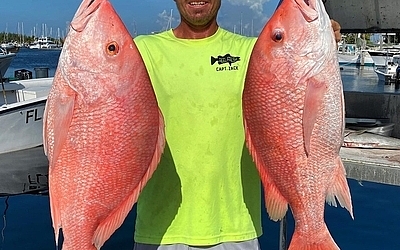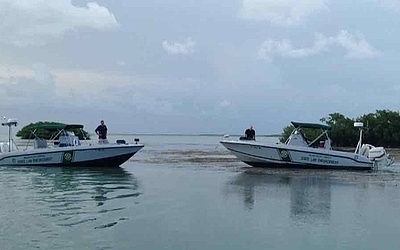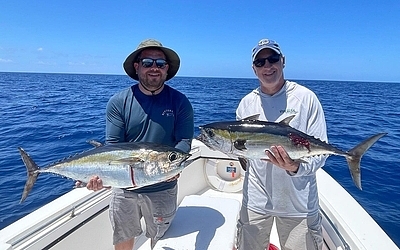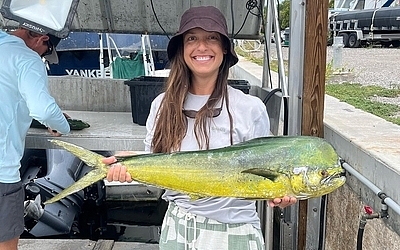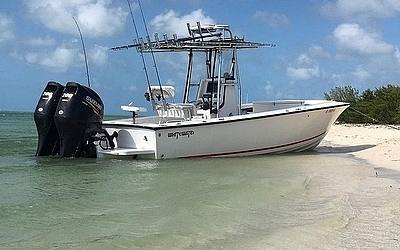Techniques for Catching Mahi-Mahi on Offshore Fishing Charters in Key West
Mahi-mahi, with their vibrant colors and acrobatic fights, are one of the most exciting fish to catch on offshore charters in Key West. These fast-swimming predators can be found in the deep blue waters off the Florida Keys, offering anglers an unforgettable fishing experience. Whether you're a seasoned pro or new to offshore fishing, knowing the right techniques can make all the difference in landing these prized gamefish. Let's dive into some proven methods for hooking mahi-mahi on your next Key West fishing adventure.
Understanding Mahi-Mahi Behavior
To catch mahi-mahi effectively, it's crucial to understand their habits and preferred habitats. These fish, also known as dorado or dolphinfish, are typically found near floating debris, weed lines, or other structure in offshore waters. They're attracted to these areas because smaller baitfish gather there for protection. Mahi-mahi are opportunistic feeders, known for their aggressive strikes and willingness to chase down lures or bait.
When targeting mahi-mahi off Key West, keep an eye out for birds circling above the water - this often indicates the presence of baitfish, which in turn attracts mahi-mahi. Look for floating sargassum weed patches or debris, as these are prime spots for finding schools of mahi. The waters around Key West offer ideal conditions for mahi-mahi fishing, with the warm Gulf Stream current bringing these fish close to shore, especially during the summer months.
Trolling Tactics That Tempt Mahi
Trolling is one of the most effective methods for catching mahi-mahi on offshore charters. This technique allows you to cover a large area and present multiple lures or baits simultaneously. When trolling for mahi-mahi, we recommend using a spread of 4-6 lines with a mix of artificial lures and natural baits.
Brightly colored lures like feathers, squid skirts, and small plastic lures in blue, green, or yellow are particularly effective. These colors mimic the small fish and squid that mahi-mahi feed on. For natural bait, rigged ballyhoo or flying fish work well. Vary your trolling speed between 6-9 knots, adjusting based on sea conditions and fish activity.
One key trolling technique is the "run and gun" method. When you spot a school of mahi-mahi, quickly troll past them, then circle back around. This mimics a school of baitfish and can trigger the mahi's predatory instincts, leading to multiple hookups.
Live Bait Strategies for Big Mahi
While trolling is effective, nothing beats live bait for enticing large mahi-mahi to strike. On our offshore fishing charters, we often use live bait like pilchards, goggle eyes, or blue runners. These lively baits create commotion in the water, attracting nearby mahi-mahi.
When fishing with live bait, use a light wire leader to prevent bite-offs from the mahi's sharp teeth. A popular rig is the "swimming pogy" - hook the live bait through the nose or back, allowing it to swim freely. This natural presentation is irresistible to hungry mahi-mahi.
Another effective live bait technique is "kite fishing." By suspending live baits from kites, you can keep them on the surface, creating a lot of splashing and commotion. This method is particularly effective for larger, more cautious mahi-mahi that might be wary of boat noise.
Casting Techniques for Active Schools
When you encounter a school of actively feeding mahi-mahi, casting can be an exciting and productive method. Light spinning tackle with 20-30 lb test line works well for this approach. Use small jigs, poppers, or stick baits that mimic fleeing baitfish.
The key to successful casting is to get your lure in front of the school quickly. Mahi-mahi are fast swimmers and can disappear just as quickly as they appear. Make long casts ahead of the school's direction of travel, then retrieve your lure with quick, erratic jerks to imitate a panicked baitfish.
Remember, mahi-mahi often travel in schools, so when you hook one, keep it in the water. The hooked fish will often attract others, giving you the opportunity to catch multiple fish from the same school.
Gear Up for Mahi Success
Having the right gear is crucial for a successful mahi-mahi fishing trip. While we provide all necessary equipment on our charters, it's helpful to understand what works best:
- Rods: Medium to heavy action rods, 6-7 feet in length
- Reels: Quality spinning or conventional reels with smooth drags
- Line: 20-30 lb test monofilament or braided line
- Leaders: 40-60 lb fluorocarbon leaders
- Hooks: 5/0 to 7/0 circle hooks for live bait
This setup provides the perfect balance of strength to handle big mahi-mahi while still allowing for an exciting fight. Circle hooks are particularly effective as they tend to hook fish in the corner of the mouth, making catch and release easier if needed. When fishing for mahi-mahi, it's important to have gear that can withstand their powerful runs and acrobatic jumps, ensuring you don't lose that trophy fish at the last moment.
Mastering the Mahi Fight
Once you've hooked a mahi-mahi, the real excitement begins. These fish are known for their spectacular aerial displays and powerful runs. When fighting a mahi-mahi, keep your rod tip up and maintain steady pressure. Be prepared for sudden changes in direction and explosive jumps.
As you bring the fish closer to the boat, be ready for its final burst of energy. Many anglers lose mahi-mahi right at the boat when the fish makes a last-ditch effort to escape. Have a gaff or large net ready, depending on whether you plan to keep or release the fish.
Remember, mahi-mahi are excellent eating fish, but it's important to practice responsible fishing. Keep only what you plan to eat and release the rest to ensure sustainable fishing for future generations.
FAQs About Mahi-Mahi Fishing in Key West
When is the best time to catch mahi-mahi in Key West? While mahi-mahi can be caught year-round in Key West, the peak season is typically from late spring through early fall, with summer being the prime time.
What size mahi-mahi can I expect to catch? Mahi-mahi in Key West waters typically range from 5 to 30 pounds, with some trophy fish exceeding 50 pounds.
Are mahi-mahi good to eat? Absolutely! Mahi-mahi are prized for their firm, white flesh and mild, sweet flavor. They're excellent grilled, blackened, or prepared in fish tacos.
Ready for Your Mahi-Mahi Adventure?
Catching mahi-mahi off the coast of Key West is an experience like no other. With their stunning colors, acrobatic fights, and delicious taste, it's no wonder these fish are a favorite among anglers. By applying these techniques and tips on your next offshore charter, you'll increase your chances of landing these magnificent gamefish.
Ready to test your skills against Key West's mahi-mahi? We're here to make your fishing dreams a reality. Book your offshore charter with us Reel Fresh Fishing or call 305-849-3098 to start planning your ultimate Key West fishing adventure. Our experienced crew will put you on the fish and ensure you have the trip of a lifetime!
‹ Back



